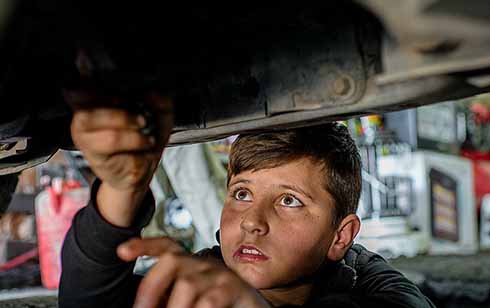 The International Labour Organization (ILO) launched the World Day Against Child Labour in 2002 to focus attention on the global extent of child labour and the action and efforts needed to eliminate it. Each year on 12 June, the World Day brings together governments, employers and workers organizations, civil society, as well as millions of people from around the world to highlight the plight of child labourers and what can be done to help them. The theme for 2019 is ‘Children shouldn’t work in fields, but on dreams!’
The International Labour Organization (ILO) launched the World Day Against Child Labour in 2002 to focus attention on the global extent of child labour and the action and efforts needed to eliminate it. Each year on 12 June, the World Day brings together governments, employers and workers organizations, civil society, as well as millions of people from around the world to highlight the plight of child labourers and what can be done to help them. The theme for 2019 is ‘Children shouldn’t work in fields, but on dreams!’
Childhood is a fairly modern invention. That does not mean, of course, that children only became children in recent times. But they have often been thought of as little adults and compelled to act like them. You can see this in family portraits well into the 19th century. In them children were dressed as adults and cajoled into adult expressions. They were prepared for their adult roles from birth.
VILLAGE LIFE
This corresponded to life among village peoples, too. In large families children are often allowed to play freely until they are five or so. Then they share the care of the younger children and are fully equipped for their adult work by the age of nine. In Central America girls will have carried water, sought out firewood, and learned to prepare the cactus for hemp or work in the rice fields. Girls could be betrothed at 12 and celebrate their initiation into adulthood at 15.
The idea that childhood might have several stages arose in a period when adult roles in society required more education and formation. As a result children were dependent on their families for longer and were slower to accept adult responsibilities.
CHANGING ROLES
Child labour needs to be seen in the light of the changing roles of children and demands of adulthood in different cultures. What might be reasonable in a poor rural society where the whole family is engaged in making a living would be totally out of place in an urban society where workers are contracted to businesses and children need a long education to thrive as adults. Debates about child labour began in the industrial revolution when enclosures and falling agricultural prices forced families into towns. Mills, mines and other industries sought the labour of children because they were more compliant, could work long hours in tightly enclosed spaces and could be paid less.
In an age where businesses took no responsibility for safety, health and morale, children’s welfare was gravely compromised by working practices and the need of families for the meagre income they could bring in. Charles Dickens represented these children in his novels and challenged the prevailing attitudes to their work. This opposition strengthened during the last century.
AT RISK
Nevertheless, children are still at risk in many parts of the world. They are often seized and trained as soldiers for insurgencies and civil wars, particularly in Africa. They are also widely employed in dangerous mines and in factories where their health is put at risk by the spill in the industrial process. Their health is hostage to the callous focus by powerful people on amassing wealth at the expense of the disadvantaged people in their societies.
We do not see these horrors in Australia but children have been held in immigration detention centres and a shameful number of Indigenous children have been imprisoned. They may not be exploited in their work, but their treatment blights their hopes. That is true, too, of many young people in juvenile justice centres. To separate children routinely from their parents makes it more likely they will later find themselves in adult prisons. For society it is a confession of failure.
PRECIOUSNESS OF EACH CHILD
The Gospel makes central the preciousness of each child, each human being in God’s eyes. They have a preciousness and a destiny that makes it criminal to use them in a way that cripples their growth and puts out the light of hope in their eyes.
Mohammed, 14, a Syrian refugee from Kobani, works underneath a car at a repair shop in Erbil, Iraq in March 2016. An ILO study shows, there is a strong correlation between child labour and situations of conflict and disaster. UNICEF/UN020145/Yar